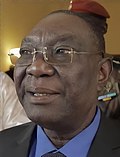Top Qs
Timeline
Chat
Perspective
List of heads of state of the Central African Republic
From Wikipedia, the free encyclopedia
Remove ads
This article lists the heads of state of the Central African Republic. There have been seven heads of state of the Central African Republic and the Central African Empire since independence was obtained from France on 13 August 1960. This list includes not only those persons who were sworn into office as President of the Central African Republic but also those who served as de facto heads of state.
Remove ads
Jean-Bédel Bokassa served as a de facto head of state (and also reigned as emperor from 1976 to 1979), while David Dacko (who served as de facto head of state from 1979 to 1981), André Kolingba, Ange-Félix Patassé, and François Bozizé were elected into office at some point during their tenure. To date, Kolingba is the only former head of state of the Central African Republic to voluntarily step down from the office through a democratic process, following the 1993 general election.
The current president of the Central African Republic is Faustin-Archange Touadéra, since 30 March 2016.[2]
Remove ads
Succession
Before the adoption of the 2023 constitution, the president of the National Assembly was the constitutional successor of the president in the event of a vacancy.[3]
Term
Before the adoption of the 2023 constitution,[4] there was a two-term limit for the president in the Constitution of the Central African Republic. The term limit was not met by any president.[5] The constitution of 2023 removed term-limits and extended the presidential term from five years to seven years.
List of officeholders
- Political parties
Rally for the Republic (RPR)
- Other affiliations
Remove ads
Footnotes
- A Dacko became the official President of the Central African Republic after defeating Abel Goumba in an internal power struggle. Dacko had support from the French government.
- B Bokassa seized power by staging a coup d'état from 31 December 1965 until 1 January 1966. Bokassa forced Dacko to officially resign from the presidency at 03:20 WAT (02:20 UTC) on 1 January.[9]
- C Bokassa staged a military coup against the Dacko government on 31 December 1965 – 1 January 1966. After becoming president, Bokassa took control of MESAN and imposed one-party rule under MESAN.
- D Bokassa, then-president for life of the Central African Republic, instituted a new constitution at the session of the MESAN congress and declared the republic a monarchy, the Central African Empire (CAE). Bokassa became the emperor of the CAE as "Bokassa I".[10]
- E By 1979, French support for Bokassa had all but eroded after the government's brutal suppression of rioting in Bangui and massacre of schoolchildren who had protested against wearing the expensive, government-required school uniforms. Dacko, who was Bokassa's personal adviser at the time, managed to leave for Paris where the French convinced him to cooperate in a coup to remove Bokassa from power and restore him to the presidency. The French successfully executed Operation Barracuda on 20–21 September 1979 and installed Dacko as president.[21][22]
- F General Kolingba (who was also the armed forces chief of staff) overthrew Dacko from the presidency in a bloodless coup.[16]
- G On 21 September 1985, Kolingba dissolved the Military Committee for National Recovery,[23] and created the positions of head of state and president.[24]
- H A constitution was adopted by a referendum on 21 November 1986 and Kolingba was elected to a six-year term in office.[11][16]
- I The country held a multiparty presidential election on 22 August and 19 September 1993. Patassé was the candidate from the Movement for the Liberation of the Central African People party and ran on the platform that he would pay the previously withheld salaries to soldiers and civil servants.[25] Patassé defeated Dacko, Kolingba, Bozizé and Abel Goumba to win the election.[26]
- J Bozizé's second coup attempt was successful; he seized power in Bangui on 15 March 2003.[27]
- K Djotodia ousted Bozizé in the 2012–13 conflict; he seized power in Bangui on 24 March 2013.[28][29]
- L Under pressure from other central African heads of state gathered for a crisis summit on the situation in CAR, Djotodia resigned in N'Djamena, Chad on 10 January 2014.[30]
Remove ads
Timeline

Latest election
Remove ads
See also
References
External links
Wikiwand - on
Seamless Wikipedia browsing. On steroids.
Remove ads











